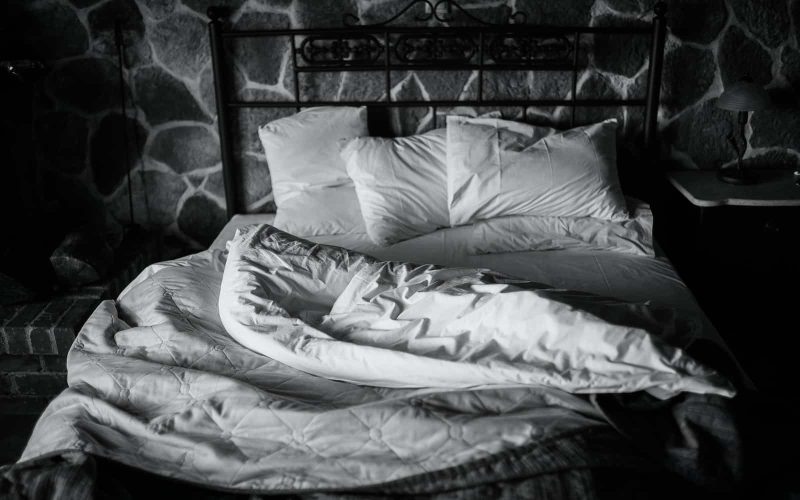Navigating the bedding world can be confusing, but we don’t want you to lose sleep over it.
The fluff you choose to cover your bed is arguably more important than the sheets or mattress! This is why we must examine the debate over the difference between duvets and comforters.
Duvet or comforter? That is the question. As a team of young millennials, we struggle with making our beds in the morning, let alone knowing which piece is which in the bedding set.
That’s why we’re determined to set the records on this duvet vs comforter case once and for all.
When it’s time to choose your bedding, which option is best for you? Do you hate making your bed? Do you mind the ease of washing? These are all the things to consider when deciding your bedding.
“Duvet” and “Comforter” are often used interchangeably, so shoppers will naturally not notice the differences between them.
However, while some may confuse a comforter with a duvet or vice versa, there is a significant standard difference between a duvet and a comforter.
As both are used to provide warmth, they differ in softness, care instructions, and more.
Learn the difference between a duvet and a comforter and duvet covers and coverlets for a comfortable sleep.
You might think a bedspread is just a bedspread, but our research proves otherwise.
When debating between a duvet and a comforter, there are some important differences you should be aware of before buying.
Difference Between Duvet and Comforter
There are several key differences between a duvet and a comforter. First, a comforter is made to be used as it is—it is a complete, quilted piece.
On the other hand, a duvet is designed to be used with a duvet cover, top quilt, or coverlet. This makes the comforter easier to use, but duvets are easier to clean.
Remove the cover and put it in the wash. Here, there would be no bulky comforter to unbalance your washing machine.
Duvets and comforters vary in price depending on the material from which they are made.
A comforter can be a bit more affordable initially since you won’t have to buy a cover and could save money for a bedding set.
In the long run, duvets can be better valued because the duvet cover protects the insert, and changing the style only requires buying a new cover.
The range of designs available for duvet covers can make duvet more versatile.
However, since they tend to be warmer than a comforter, they may not be ideal for year-round use. Sleepers can combine a comforter year-round with a blanket in the winter, but the look is consistent and offers less design versatility.
The duvet can also keep you warm. It was initially designed to be used without a top sheet or additional blankets, but many people still add them.
That’s not to say there aren’t similarities between duvets and comforters. Both provide thick, fluffy coverage to keep you warm and are available in different thicknesses and materials for temperature regulation.
Whether you like your bed to look like a big white cloud or you like to brighten things up with bright colors or patterns, your bedding options provide an easy way to personalize your bed.
So then, what is a duvet? What is a comforter? Does a duvet cover only work with a duvet? And what the heck is a coverlet? Let’s clarify the difference between a duvet and a comforter.
What is a Duvet?
This may seem simple, but confusion tends to be the answer. “Duvet” is the French word for down, reflecting the traditional filling of this bedding originating in Europe.
Down is a layer of fine feathers found under the outer feathers of geese and ducks. This soft, fluffy material insulates quite well, giving duvets their reputation for warmth.
While duvets were originally filled with down, many now use feathers, down alternatives, wool, cotton, or silk to suit different needs and preferences.
A duvet is a soft blanket that is usually filled with synthetic fibers or down, such as feathers or wool.
Unlike comforters, duvets don’t need to be quilted or stitched in, so they have a less “finished” look. Duvets are designed as inserts and sold separately from duvet covers or coverlets.
This is why you can mix and match them with other bedding without being tied to a full set like you would with a comforter.
A duvet insert generally consists of filler inserted into a plain cotton, polyester, or cotton/polyester blend shell.
While some owners may choose to use just an insert, duvet inserts are designed to pair with a duvet cover for easier cleaning and more style options.
What is a Duvet Cover?
You might wonder what a duvet cover is and how to use it. A duvet is a duvet cover, and a pillow is a pillowcase. Tuck the garment into the duvet cover and close the ends.
They’re designed to be easy to remove and wash, so you don’t have to worry about washing and drying your thick duvet.
The duvet covers are also designed to be interchangeable, so you can easily decorate your bed without buying a whole new bedding set. They can also be used with comforters, but check the size.
Duvets can provide enough warmth that you don’t need extra sheets or blankets. If you use it with a duvet cover, you can still use sheets, but some people find them unnecessary.
It’s up to you, and we are not here to tell you how to make your bed.
Cover materials include cotton, flannel, silk, linen, and faux fur. To prevent movement, these covers are usually attached to the insert with ties, buttons, or a zipper.
Although washable duvet inserts are available, many have specific care instructions to prevent damage. Duvet covers, on the other hand, are usually machine washable.
Duvet inserts vary in price depending on their quality and materials. Covers can also add to the overall cost, especially if you want more options for changing up the look of your bedding.
What is a Coverlet?
It is a non-reversible top covering that is usually quilted or woven. Its main use is as a decorative layer to cover a thick duvet or comforter, but it cannot be attachable.
They are commonly used on beds in hotel rooms to add an aesthetic touch. However, they are not limited to just beds; They can also be used on chairs or sofas.
What is a Comforter?
Since we are on the difference between duvet and comforter, a comforter is made to be used as it is, without the need for an additional cover as it is already built-in.
While a duvet has roots in Europe, a comforter is their American equivalent.
Many of the same materials used in duvets can also be in comforters. They often have covers made of cotton, polyester, or cotton/polyester blends filled with down, alternative down, feathers, cotton, wool, or silk.
Comforters are often not as warm or soft as duvets, so some owners prefer to combine them with an extra blanket during colder months.
Comforters are usually sold in bedding sets, or bed-in-a-bag sets with other matching pieces, such as sheets and pillowcases, all designed for the same size bed.
They are intended as a final piece and should not be covered with anything or combined with additional accessories. This makes organizing your bed very simple.
Many styles, colors, patterns, and textures are available on the market.
Bedding sets also regularly include a comforter for shoppers who want to achieve a coordinated look with little effort.
Care instructions differ between comforters depending on the material they are made from. If the comforter is machine washable, putting it in the washing machine at home can be quite challenging.
Most duvet owners use a top sheet that acts as a barrier, reducing the need for frequent washing.
Some comforters can also be combined with duvet covers for additional protection.
Comforters are available at a wide range of prices that reflect their material.
Bedding sets that include a comforter are often affordable, while luxury sleepers can find plenty of options that use high-quality materials like down and silk.
How to Wash a Duvet or Comforter
There is a slight difference between duvet and comforter washing techniques when it comes to cleaning. Please note that these are general guidelines, and you should check the label on your duvet or comforter before washing.
Since comforters come in many different fabrics, it is especially important to pay attention to the washing instructions on the comforter’s label and packaging.
Most comforters can be washed in the washing machine on some heat settings, but some will require dry cleaning.
Duvets, on the other hand, are usually dry-cleaned only. However, a duvet cover can easily be removed and thrown in the washing machine, so you shouldn’t need to clean the duvet itself often.
Duvet Vs Comforter: Pros and Cons
Duvets Pros
- Lightweight fabrics make them fluffier.
- Easy to clean
- Easily refresh the look of your bed.
- It is more versatile because you can easily change your style.
- The cover and insert are easy to change.
Duvet Cons
- It does not provide as much coverage (overhang) as a comforter
- It may be subject to bunching inside the cover.
- sometimes uncomfortable to assemble
- You may need to purchase the cover separately
Comforter Pros
- No assembly is required; they are ready to use right out of the bag.
- Keeps its shape.
- It can be used with a duvet cover.
- It often comes in matching bedding sets. It is ideal for decoration as it hangs more over the bed than duvets.
Comforter Cons
- Harder to clean
- They tend to flatten out over time.
- You are limited to one style.
- They may not be able to give enough warmth during the winter months.
Other Considerations
Now that you know the difference between a duvet and a comforter, here are a few more things to keep in mind when shopping.
Price
Duvets and comforters can usually be found for the same price. However, prices may vary depending on the manufacturer and the materials used.
Duvets and comforters filled with feathers will be more expensive than synthetic fibers-filled duvets and comforters.
Also, since duvets come in two pieces that can be sold separately, they can sometimes come off on the more expensive side.
When shopping for a duvet, ensure it comes with both pieces to avoid additional charges.
Care
If you are concerned about the difference between duvet and comforter caring methods, a duvet will be easier to clean.
The cover is immediately removable and can be washed in the washing machine, while the comforter is one-piece and voluminous.
You can also easily replace the duvet cover if it gets stained or destroyed. The comforter must often be taken to a dry cleaner to be cleaned appropriately.
Personal style
In terms of design, comforters can add a layered look to your bed. They are usually designed to go over the top sheet and hang to the side.
It also works well with sheets and pillowcases, creating a cohesive design. They are quick, easy to assemble, and often come in matching comforter sets.
A duvet is the best option if you want a simpler look that you can change up often. Duvets offer a more streamlined design.
They adapt to the size of your mattress so that the fabric does not catch on the sides. They are also fluffier.
Many people forgo the top sheet and just use a duvet and duvet cover—this sleeping style originated in Europe.
How are Duvets and comforters similar?
The similarities between the two are that they act as the main thick and fluffy blanket on your bed.
Both should appeal to you aesthetically (with or without the cover), as they will be the main visible feature most of the time.
Sometimes, you need to choose a duvet cover or comforter that matches the look you’re going for.
What to choose?
Since we know the difference between a duvet and a comforter, we should know that both are great options for keeping you warm on cold nights and giving your bed a more finished look.
Ultimately, one or the other may work for you, depending on what you like.
People who don’t need as much extra warmth and those who prefer to avoid a cover may prefer a comforter, while a duvet may be ideal for people looking for extra thickness and more styling options.
You may prefer a duvet if:
- Love the more luxurious feel
- You like to change the look of your bed more often
- You prefer not to use the top sheet
You may prefer a comforter if:
- You don’t want to bother about a cover
- You prefer to buy one piece
- You are purchasing the bedding as a set








